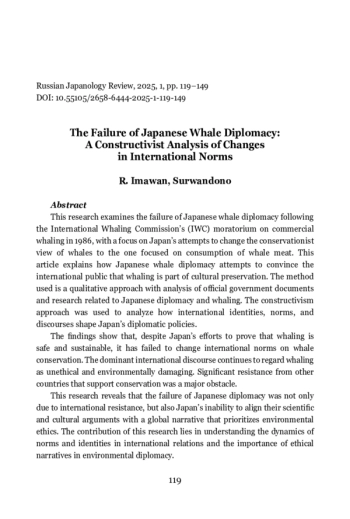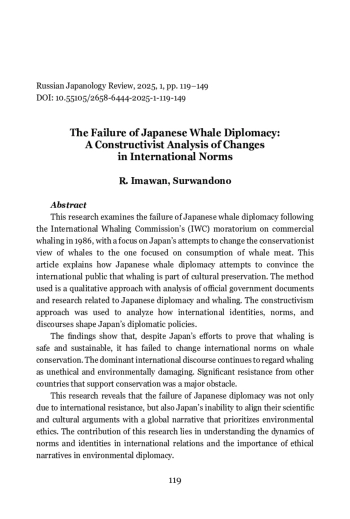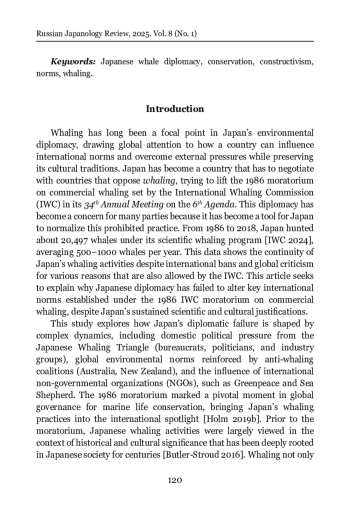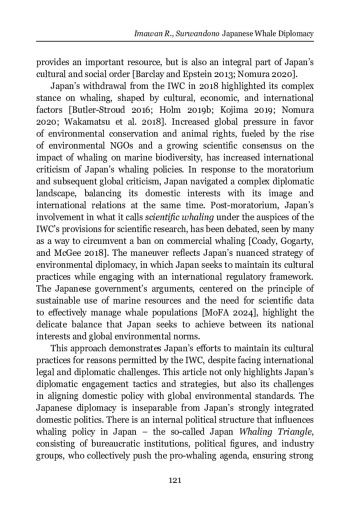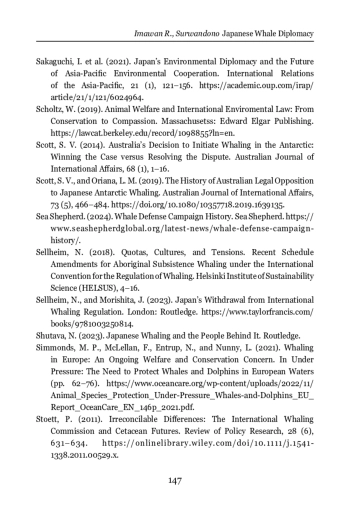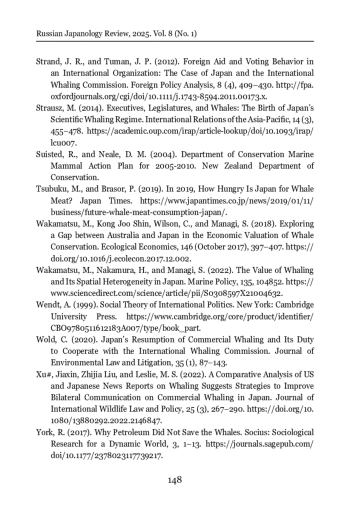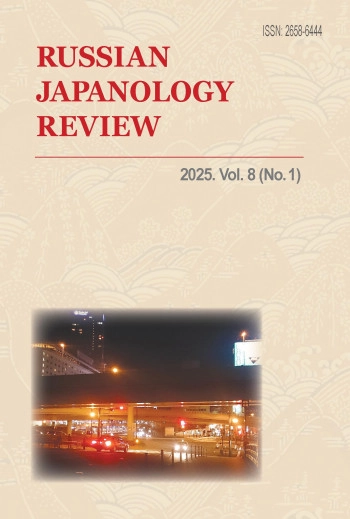This research examines the failure of Japanese whale diplomacy following the International Whaling Commission’s (IWC) moratorium on commercial whaling in 1986, with a focus on Japan’s attempts to change the conservationist view of whales to the one focused on consumption of whale meat. This article explains how Japanese whale diplomacy attempts to convince the international public that whaling is part of cultural preservation. The method used is a qualitative approach with analysis of official government documents and research related to Japanese diplomacy and whaling. The constructivism approach was used to analyze how international identities, norms, and discourses shape Japan’s diplomatic policies.
The findings show that, despite Japan’s efforts to prove that whaling is safe and sustainable, it has failed to change international norms on whale conservation. The dominant international discourse continues to regard whaling as unethical and environmentally damaging. Significant resistance from other countries that support conservation was a major obstacle.
This research reveals that the failure of Japanese diplomacy was not only due to international resistance, but also Japan’s inability to align their scientific and cultural arguments with a global narrative that prioritizes environmental ethics. The contribution of this research lies in understanding the dynamics of norms and identities in international relations and the importance of ethical narratives in environmental diplomacy.
Идентификаторы и классификаторы
Whaling has long been a focal point in Japan’s environmental diplomacy, drawing global attention to how a country can influence international norms and overcome external pressures while preserving its cultural traditions. Japan has become a country that has to negotiate with countries that oppose whaling, trying to lift the 1986 moratorium on commercial whaling set by the International Whaling Commission (IWC) in its 34th Annual Meeting on the 6th Agenda. This diplomacy has become a concern for many parties because it has become a tool for Japan to normalize this prohibited practice. From 1986 to 2018, Japan hunted about 20,497 whales under its scientific whaling program [IWC 2024], averaging 500–1000 whales per year. This data shows the continuity of Japan’s whaling activities despite international bans and global criticism for various reasons that are also allowed by the IWC. This article seeks to explain why Japanese diplomacy has failed to alter key international norms established under the 1986 IWC moratorium on commercial whaling, despite Japan’s sustained scientific and cultural justifications.
Список литературы
1. Acharya, A. (2004). How Ideas Spread: Whose Norms Matter? Norm Localization and Institutional Change in Asian Regionalism. International Organization, 58 (02), 483-519. http://www.journals.cambridge.org/abstract_S0020818304582024.
2. Barclay, K., and Epstein, C. (2013). Securing Fish for the Nation: Food Security and Governmentality in Japan. Asian Studies Review, 37 (2), 215-333. http://www.tandfonline.com/doi/abs/. DOI: 10.1080/10357823.2013.769498
3. Berkowitz, H., and Grothe-Hammer, M. (2022). From a Clash of Social Orders to a Loss of Decidability in Meta-Organizations Tackling Grand Challenges: The Case of Japan Leaving the International Whaling Commission. Research in the Sociology of Organizations, 115-138. https://www.emerald.com/insight/content/doi//full/html. DOI: 10.1108/S0733-558X20220000079010
4. Betsill, M. M. (2007). Reflections on the Analytical Framework and NGO Diplomacy. In NGO Diplomacy (pp. 177-206), The MIT Press. https://direct.mit.edu/books/book/3214/chapter/91655/Reflections-on-the-Analytical-Framework-and-NGO.
5. Butler-Stroud, C. (2016). What Drives Japanese Whaling Policy? Frontiers in Marine Science, 3 (JUN), 1-4. http://journal.frontiersin.org/Article//abstract. DOI: 10.3389/fmars.2016.00102
6. Caddell, R. (2014). Science Friction: Antarctic Research Whaling and the International Court of Justice. Journal of Environmental Law, 26 (2), 331-340.
7. Caddel, R. (2023). Marine Mammals and Migratory Species. In Research Handbook on International Marine Environmental Law (pp. 333-359), Edward Elgar Publishing. https://www.elgaronline.com/view/book/9781789909081/book-part-9781789909081-24.xml.
8. Coady, D., Gogarty, B., and McGee, J. (2018). Scientific Whaling and How Philosophy of Science Can Help Break the International Deadlock. Australian Journal of International Affairs, 72 (1), 49-67. DOI: 10.1080/10357718.2017.1334758
9. Cunningham, P. A., Huijbens, E. H., and Wearing, S. L. (2012). From Whaling to Whale Watching: Examining Sustainability and Cultural Rhetoric. Journal of Sustainable Tourism, 20 (1), 143-161. https://www.tandfonline.com/doi/full/. DOI: 10.1080/09669582.2011.632091
10. Danaher, M. (2002). Why Japan Will Not Give up Whaling. Pacifica Review: Peace, Security & Global Change, 14 (2), 105-120.
11. Deitelhoff, N., and Zimmermann, L. (2018). Things We Lost in the Fire: How Different Types of Contestation Affect the Robustness of International Norms. International Studies Review, 22 (1), 51-76. https://academic.oup.com/isr/advance-article/doi/. DOI: 10.1093/isr/viy080/5266952
12. Dippel, C. (2015). Foreign Aid and Voting in International Organizations: Evidence from the IWC. Journal of Public Economics, 132, 1-12. DOI: 10.1016/j.jpubeco.2015.08.012
13. Dorsey, K. (2014). Whales and Nations: Environmental Diplomacy on the High Seas. Washington: University of Washington Press. https://www.jstor.org/stable/j.ctvcwngrn. EDN: WPDQWB
14. Dorsey, K., and Cronon, W. (2014). Whales and Nations: Environmental Diplomacy on the High Seas. University of Washington Press. https://books.google.co.id/books?id=eNkYAgAAQBAJ. EDN: WPDQWB
15. Fielding, R. (2022). Whalers in ‘A Post-Whaling World’: Sustainable Conservation of Marine Mammals and Sustainable Development of Whaling Communities-With a Case Study from the Eastern Caribbean. Sustainability, 14 (14), 8782. https://www.mdpi.com/2071-1050/14/14/8782. EDN: HXHAJY
16. Finnemore, M., and Sikkink, K. (1998). International Norm Dynamics and Political Change. International Organization, 52 (4), 887-917. https://www.cambridge.org/core/product/identifier/S0020818398440608/type/journal_article. EDN: CUHBGD
17. Fitzmaurice, M. (2015). Whaling and International Law. Cambridge University Press. Gray, C. A., and Kennelly, S. J. (2018). Bycatches of Endangered, Threatened and Protected Species in Marine Fisheries. Reviews in Fish Biology and Fisheries, 28 (3), 521-541. DOI: 10.1007/s11160-018-9520-7 EDN: NYMTJX
18. Greenpeace. (2024). Save the Whales. Greenpeace. https://www.greenpeace.org/usa/oceans/save-the-whales/.
19. Harrell, A. M. (2020). Whaling in Japan: Conflicts and Controversies Surrounding a Dying Tradition. The Macksey Journal, 1, 185. https://mackseyjournal.scholasticahq.com/article/21871-whaling-in-japanconflicts-and-controversies-surrounding-a-dying-tradition.
20. Harris, P. G. (2022). Routledge Handbook of Marine Governance and Global Environmental Change. Routledge Handbook of Marine Governance and Global Environmental Change.
21. Hein, P. (2023). When Domestic Interests and Norms Undermine the Rules-Based Order: Reassessing Japan’s Attitude toward International Law. Asian Journal of Comparative Politics, 8 (4), 895-922. http://journals.sagepub.com/doi/. DOI: 10.1177/20578911231168206 EDN: BKZQXC
22. Holm, F. (2019a). After Withdrawal from the IWC: The Future of Japanese Whaling. Asia-Pacific Journal: Japan Focus, 17 (4). https://apjjf.org/2019/04/holm.
23. Holm, F. (2019b). Japan’s Whaling Policy: The Reasons for Leaving the International Whaling Commission 1. In Japan 2019: Politik, Wirtschaft, Gesellschaft (November) (pp. 126-151). https://www.researchgate.net/publication/337387724_Japan’s_Whaling_Policy_The_Reasons_for_Leaving_the_International_Whaling_Commission.
24. Holt, S. J. (1999). Whaling and International Law and Order. Marine Pollution Bulletin, 38 (7), 531-534. https://linkinghub.elsevier.com/retrieve/pii/S0025326X98001544. EDN: ADCOZP
25. Imawan, R., Wirasenjaya, A. M., and Zhafran, M. Y. (2021). Japan’s Rejection of International Norms against Whaling“ In M. Senge et al. (eds.), E3S Web of Conferences, 316, 04016. https://www.e3s-conferences.org/. DOI: 10.1051/e3sconf/202131604016
26. IWC. (2011). Chair’s Report of the 63rd Annual Meeting. https://archive.iwc.int/pages/download_progress.php?ref=66&size=&ext=pdf&k=.
27. IWC. (2024). Total Catches. International Whaling Commission. https://iwc.int/management-and-conservation/whaling/total-catches.
28. Japan Times. (2022). A Middle Way to Whaling. Japan Times. https://www.japantimes.co.jp/opinion/2002/05/22/editorials/a-middle-way-towhaling/.
29. Imawan R., Surwandono Japanese Whale Diplomacy Kagawa-Fox, M. (2009). Japan’s Whaling Triangle - The Power Behind the Whaling Policy. Japanese Studies, 29 (3), 401-414. http://www.tandfonline.com/doi/abs/. DOI: 10.1080/10371390903298078
30. Kato, K. (2007). Prayers for the Whales: Spirituality and Ethics of a Former Whaling Community- Intangible Cultural Heritage for Sustainability. International Journal of Cultural Property, 14, 283-313.
31. Kojima, C. (2019). Japan’s Decision to Withdraw from the International Convention for the Regulation of Whaling. Asia-Pacific Journal of Ocean Law and Policy, 4, 93-96.
32. Kolmaš, M. (2020a). International Pressure and Japanese Withdrawal from the International Whaling Commission: When Shaming Fails. Australian Journal of International Affairs, 75 (2), 197-216. DOI: 10.1080/10357718.2020.1799936 EDN: INSQUZ
33. Kolmaš, M. (2020b). When Shaming Fails: Japanese Withdrawal from the International Whaling Commission. Australia Institute of International Affairs. https://www.internationalaffairs.org.au/australianoutlook/whenshaming-fails-japanese-withdrawal-from-the-international-whalingcommission/.
34. Maruf, M., and Yen-Chiang Chang. (2023). Strengthening the Regulatory Framework for the Conservation of Cetaceans and Migratory Marine Species against Anthropogenic Underwater Noise. The International Journal of Marine and Coastal Law, 39 (1), 5-38. https://brill.com/view/journals/estu/39/1/article-p5_2.xml.
35. Mascia, M. B., and Mills, M. (2018). When Conservation Goes Viral: The Diffusion of Innovative Biodiversity Conservation Policies and Practices. Conservation Letters, 11 (3), 1-9. https://conbio.onlinelibrary.wiley.com/doi/. DOI: 10.1111/conl.12442
36. Matsuoka, K. (2018). The Full Story Behind Japan’s Decision to Withdraw from the International Whaling Commission. Kodansha. https://gendai.media/articles/-/59221.
37. Mauad, A., and Betsill, M. (2019). A Changing Role in Global Climate Governance: São Paulo Mixing Its Climate and International Policies. Revista Brasileira de Politica Internacional, 62 (2).
38. McCurry, J. (2021). Japan’s Whaling Town Struggles to Keep 400 Years of Tradition Alive. The Guardian. https://www.theguardian.com/world/2021/dec/26/japans-whaling-town-struggles-to-keep-400-years-of-traditionalive.
39. Milstein, T., McGaurr, L., and Lester, L. (2021). Make Love, Not War?: Radical Environmental Activism’s Reconfigurative Potential and Pitfalls. Environment and Planning E: Nature and Space, 4 (2), 296-316. https://journals.sagepub.com/doi/. DOI: 10.1177/2514848620901443 EDN: OINCRT
40. MoFA. (2024). Japan and the Management of Whales. Ministry of Foreign Affairs. https://www.mofa.go.jp/policy/economy/fishery/whales/japan.html.
41. NAMMCO. (2023). Report of the Scientific Committee Ad Hoc Working Group On Narwhal in East Greenland. https://nammco.no/wp-content/uploads/2024/01/report_negwg-2023.pdf.
42. Nomura, K. (2020). Antiwhaling Groups in Japan: Their Historical Lack of Development and Relationship With National Identity. The Journal of Environment & Development, 29 (2), 223-244. https://journals.sagepub.com/doi/. DOI: 10.1177/1070496519878218
43. Panigada, S. et al. (2024). Editorial: The ACCOBAMS Survey Initiative (ASI): Implementing Large Scale Surveys for Marine Megafauna in the Mediterranean and Black Seas. Frontiers in Marine Science, 11 (November), 10-12.
44. Papastavrou, V., and Ryan, C. (2023). Ethical Standards for Research on Marine Mammals. Research Ethics, 19 (4), 390-408. https://journals.sagepub.com/doi/. DOI: 10.1177/17470161231182066 EDN: PELKSQ
45. Rayfuse, R., Jaeckel, A., and Klein, N. (2023). International Marine Environmental Law and Policy. Edward Elgar Publishing. https://www.routledge.com/International-Marine-Environmental-Law-and-Policy/Hassan-Karim/p/book/9781138651135?srsltid=AfmBOoqpM6cncsADyUj_eqaR6yNx8a511CNp6Ci_aAkrxW75IHeeEd8V.
46. Rots, A. P., and Haugan, E. (2023). Whaling on Stage: A Comparison of Contemporary Japanese Whale Festivals. Religion, 53 (3), 528-553. DOI: 10.1080/0048721X.2023.2211393 EDN: RWUIMV
47. Sakaguchi, I. et al. (2021). Japan’s Environmental Diplomacy and the Future of Asia-Pacific Environmental Cooperation. International Relations of the Asia-Pacific, 21 (1), 121-156. https://academic.oup.com/irap/article/21/1/121/6024964. EDN: JXNXVJ
48. Scholtz, W. (2019). Animal Welfare and International Enviromental Law: From Conservation to Compassion. Massachusetss: Edward Elgar Publishing. https://lawcat.berkeley.edu/record/1098855?ln=en.
49. Scott, S. V. (2014). Australia’s Decision to Initiate Whaling in the Antarctic: Winning the Case versus Resolving the Dispute. Australian Journal of International Affairs, 68 (1), 1-16.
50. Scott, S. V., and Oriana, L. M. (2019). The History of Australian Legal Opposition to Japanese Antarctic Whaling. Australian Journal of International Affairs, 73 (5), 466-484. DOI: 10.1080/10357718.2019.1639135
51. Sea Shepherd. (2024). Whale Defense Campaign History. Sea Shepherd. https://www.seashepherdglobal.org/latest-news/whale-defense-campaignhistory/.
52. Sellheim, N. (2018). Quotas, Cultures, and Tensions. Recent Schedule Amendments for Aboriginal Subsistence Whaling under the International Convention for the Regulation of Whaling. Helsinki Institute of Sustainability Science (HELSUS), 4-16.
53. Sellheim, N., and Morishita, J. (2023). Japan’s Withdrawal from International Whaling Regulation. London: Routledge. https://www.taylorfrancis.com/books/9781003250814.
54. Shutava, N. (2023). Japanese Whaling and the People Behind It. Routledge.
55. Simmonds, M. P., McLellan, F., Entrup, N., and Nunny, L. (2021). Whaling in Europe: An Ongoing Welfare and Conservation Concern. In Under Pressure: The Need to Protect Whales and Dolphins in European Waters (pp. 62-76). https://www.oceancare.org/wp-content/uploads/2022/11/Animal_Species_Protection_Under-Pressure_Whales-and-Dolphins_EU_Report_OceanCare_EN_146p_2021.pdf.
56. Stoett, P. (2011). Irreconcilable Differences: The International Whaling Commission and Cetacean Futures. Review of Policy Research, 28 (6), 631-634. https://onlinelibrary.wiley.com/doi/.x. DOI: 10.1111/j.1541-1338.2011.00529
57. Strand, J. R., and Tuman, J. P. (2012). Foreign Aid and Voting Behavior in an International Organization: The Case of Japan and the International Whaling Commission. Foreign Policy Analysis, 8 (4), 409-430. http://fpa.oxfordjournals.org/cgi/doi/.x. DOI: 10.1111/j.1743-8594.2011.00173
58. Strausz, M. (2014). Executives, Legislatures, and Whales: The Birth of Japan’s Scientific Whaling Regime. International Relations of the Asia-Pacific, 14 (3), 455-478. https://academic.oup.com/irap/article-lookup/doi/. DOI: 10.1093/irap/lcu007
59. Suisted, R., and Neale, D. M. (2004). Department of Conservation Marine Mammal Action Plan for 2005-2010. New Zealand Department of Conservation.
60. Tsubuku, M., and Brasor, P. (2019). In 2019, How Hungry Is Japan for Whale Meat? Japan Times. https://www.japantimes.co.jp/news/2019/01/11/business/future-whale-meat-consumption-japan/.
61. Wakamatsu, M., Kong Joo Shin, Wilson, C., and Managi, S. (2018). Exploring a Gap between Australia and Japan in the Economic Valuation of Whale Conservation. Ecological Economics, (October 2017), 397-407. DOI: 10.1016/j.ecolecon.2017.12.002
62. Wakamatsu, M., Nakamura, H., and Managi, S. (2022). The Value of Whaling and Its Spatial Heterogeneity in Japan. Marine Policy, 135, 104852. https://www.sciencedirect.com/science/article/pii/S0308597X21004632. EDN: LIXUAD
63. Wendt, A. (1999). Social Theory of International Politics. New York: Cambridge University Press. https://www.cambridge.org/core/product/identifier/CBO9780511612183A007/type/book_part.
64. Wold, C. (2020). Japan’s Resumption of Commercial Whaling and Its Duty to Cooperate with the International Whaling Commission. Journal of Environmental Law and Litigation, 35 (1), 87-143.
65. Xu#, Jiaxin, Zhijia Liu, and Leslie, M. S. (2022). A Comparative Analysis of US and Japanese News Reports on Whaling Suggests Strategies to Improve Bilateral Communication on Commercial Whaling in Japan. Journal of International Wildlife Law and Policy, 25 (3), 267-290. DOI: 10.1080/13880292.2022.2146847 EDN: VWPCMA
66. York, R. (2017). Why Petroleum Did Not Save the Whales. Socius: Sociological Research for a Dynamic World, 3, 1-13. https://journals.sagepub.com/doi/. DOI: 10.1177/2378023117739217
Выпуск
Другие статьи выпуска
The article analyzes the Japanese official narrative about the Northern Territories, which is widespread in Japanese society as a key factor in the formation of the bad image of Russia in Japan. Of particular importance from the point of view of the emotional effect on public consciousness is the thesis that the Southern Kurils are the “ancestral territory of Japan,” that the USSR committed aggressive and unfair actions against Japan during World War II, and modern Russia did not correct them, and that the Japanese natives of the Southern Kurils experience enormous moral suffering, not having the opportunity to freely visit the graves of their ancestors. The article examines the organizational structure of state, public, and socio-political organizations designed to ensure public policy to popularize this narrative and shows the features of its reflection in school textbooks, museums, and memorial complexes. The author focuses on the Movement for the Return of the Northern Territories and the events held within its framework, including the annual “Northern Territories Day,” held on February 7.
It is concluded that, despite all the efforts of the government, Japanese public opinion in reality turns out to be relatively poorly informed about the problem of the Northern Territories. At the same time, as generations change, the interest in this problem is gradually decreasing, especially among young people. There is a process of realizing the futility of maintaining a hard line in the problem, related to visits to graves by former islanders and members of their families, causes the greatest public outcry, but even this aspect, as the results of public opinion polls show, has a limited effect. government’s approach to solving it. The humanitarian aspect of the
In the late 1930s and early 1940s, Soviet-Japanese relations were going through difficult times. The Mongolian issue and border incidents continually worsened bilateral contacts. In a state of hostility and open confrontation, the authorities of both countries detained and rummaged fishing vessels, artificially whipped up spy mania, increased pressure on left-wing elements (Japan) and arrested those who were associated with the enemy side through scientific or other work (the USSR). Limiting himself to two events from Soviet-Japanese history of this time, the author analyzes how Soviet-Japanese relations and the atmosphere of mutual perception changed in the period between the end of the Khalkhin Gol River conflict (1939) and the signing of the Neutrality Pact (1941).
Using reports from employees of the USSR Plenipotentiary Mission in Tokyo as an example, the author examines how Japan’s attempt to begin building “new relations” with the USSR affected the position of Soviet diplomats and influenced the degree and quality of interaction between them and the Japanese.
The period from the end of the Russo-Japanese War to the 1917 October Revolution was a time of political, economic, and cultural rapprochement between Russia and Japan. Moreover, this rapprochement was observed after the events of 1917 for several more years, since, during the Russian Civil War, Japan supported the anti-Bolshevik forces in the Far East.
The two countries entered the First World War as de facto allies; this alliance culminated in the Treaty of 1916. Its reflection in symbolic actions was also an element of this cooperation. In the years before the First World War, and, actually, during the war, hundreds of Japanese servicemen were given Russian awards. The article analyzes the composition of military personnel, what awards and for what merits were presented to the members of the Imperial House who did military service, diplomats, generals, as well as fleet admirals and naval officers, engineers, and divers.
After October 1917, Japan supported members of the White Movement and Admiral A. V. Kolchak for several more years. In addition, even more active support was provided to Ataman G. M. Semenov. For example, Japanese garrisons were stationed in Transbaikalia starting from the autumn of 1918, when he came to power there. Paradoxically, many Japanese officers and enlisted men were presented with Russian awards during the years of the Civil War, which fact is also confirmed in archival documents.
The article is devoted to the problems of Russian-Japanese relations on the Chinese Eastern Railway at the initial stage of its history. Workers from Japan were not invited to build the road, but the Japanese were already among the first settlers in the city of Harbin, founded in 1898 by the Chinese Eastern Railway Society. After a short break caused by the Russo-Japanese War, bilateral relations were quickly restored. In 1906, as the Russian troops withdrew from Manchuria, the Japanese began to return to the Chinese Eastern Railway. Since 1907, Japanese officials, entrepreneurs, cultural and sports figures from Japan began to take an active part in the sociopolitical, economic, and cultural life of the city of Harbin. It was here that the first “Russian-Japanese Society” was created. The Japanese in Harbin were mainly employed in such areas as trade, medicine, entertainment, and domestic service.
An important component of bilateral cooperation was cooperation in the railway sector. Due to the tradition and the inaccessibility of sources, the history of the Japanese population of Harbin is poorly studied in Russian historiography. The purpose of the research is to restore the historical picture and identify the problems of the Japanese presence in Harbin and the Russian- Japanese interaction on the Chinese Eastern Railway in the period between the Russo-Japanese War and the First World War. The study was carried out on the basis of materials from the periodicals of Harbin, with the involvementThe information and analytical materials published in the newspapers Harbinskii Vestnik (Harbin Bulletin), Harbin, Novaya Zhizn’ (New Life), and Man’chzhurskii Kur’er (Manchurian Courier), especially advertising, allow one to get an idea of the composition of the Japanese community, the occupations of the Japanese and some problems of Russian-Japanese relations in 1906-1914. The study of development of the Chinese Eastern Railway by the Japanese, their coexistence and cooperation with the Russians in Harbin will expand knowledge of the history of the Chinese Eastern Railway and achieve a more complete and objective picture of the history of Russian-Japanese relations in the 20th century.
The manuscript Tales of the Northern Barbarians (Hokuidan, 「北夷談」) by Matsuda Denjūrō (松田伝十郎, 1769-1843) is a valuable source on the history of Russian-Japanese relations, the development of the northern territories inhabited by the Ainu conducted by the Japanese, relations between the Ainu and the Japanese, their barter trade. The written source consists of seven notebooks. The manuscript was created in the first years of the Bunsei era (文政, 1818-1831). It describes the events from 1799 to 1822 in chronological order, i. e., events that occurred during the 24 years of Matsuda’s service in the lands of the Ainu. The manuscript is written in cursive (Japanese: “grass writing”, sōsho 草書). The second half of the first book examines the bear festival and the inau, cult objects of the Ainu, which were described in detail by the author in [Klimov A. V. 2024].
This article is the continuation of the description of the events of the first notebook, in which Matsuda describes: wintering in Akkeshi, the life and clothing of the Ainu, the peculiarities of hunting sea lions, the attitude towards the moon fish, wintering in Aputa, the fight against the smallpox epidemic that arose, and his return to Edo. The text is accompanied by numerous sketches. The illustrations in the manuscript are of great value, providing additional information that is missing from the text itself. Matsuda’s descriptions refer to November 1799 - January 1801. The Hokuidan manuscript has not yet been translated into any of the European languages other than Russian. The author of this article provides translations of fragments of the written source in the chapters of published collective monographs [Klimov A. V. 2020; Klimov A. V. 2021; Klimov A. V. 2022]. The translation was carried out from the published text of the Japanese manuscript in the ten-volume series of written monuments entitled Collection of Historical Materials About the Life of the Common People of Japan (Nihon shomin seikatsu shiryō shū sei 日本庶民生活史料集成), in the fourth volume [Matsuda 1969]. In addition to this series, the Tales were published in Old Japanese in the fifth volume of a six-volume series of written monuments called Library: Northern Gate (Hokumon sō sho 北門叢書), published in 1972.
Статистика статьи
Статистика просмотров за 2025 год.
Издательство
- Издательство
- АССОЦИАЦИЯ ЯПОНОВЕДОВ
- Регион
- Россия, Москва
- Почтовый адрес
- 117218, г. Москва, Нахимовский проспект, 32
- Юр. адрес
- 117218, г. Москва, Нахимовский проспект, 32
- ФИО
- Стрельцов Дмитрий Викторович (ПРЕДСЕДАТЕЛЬ)
- E-mail адрес
- japanassoc@gmail.com
